![]()
![]()
![]()
Use LEFT and RIGHT arrow keys to navigate between flashcards;
Use UP and DOWN arrow keys to flip the card;
H to show hint;
A reads text to speech;
25 Cards in this Set
- Front
- Back
- 3rd side (hint)
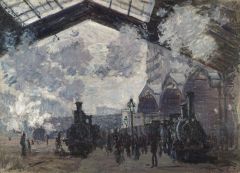
|
Claude MONET Gare St-Lazare 1877 Modernity, Modernism and the Avant-Garde – Week One: Greenburg saw the start of Modernism as the fixation of the optical effects of light – result was that brushstrokes became obvious and paintings flattened. The composition of colours, shapes, texture, line and tone considered critically. There is emphasis on line – the roof is dominant, a compression of space. The use of line draws attention to the shape of the canvas and draws the viewer’s eye to the middle of the canvas. Monet’s painting explores the dimension of the urban landscape and places the viewer in the perspective of being a passenger waiting at the station. Monet situates the viewer as an observer, not separate but contained and confined within the urban scape. The repetition of elements and shapes give the painting a compositional rhythm of the train chugging along the tracks. The use of repetitive visual elements creates an imagined soundscape – the busy, loud staccato occurring at the station. What makes it modern? The subject matter (urban landscape), compression of perspective, reduced colour pallete, using line to draw attention to the canvases edge and the artists choices are visible. |
Claude MONET Gare St-Lazare 1877 Modernity, Modernism and the Avant-Garde – Week One: |
|
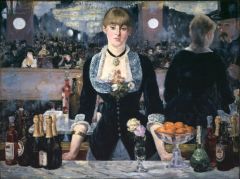
|
Edouard MANET Bar at the Folies-Bergère 1881-2 Modernity, Modernism and the Avant-Garde – Week One: This painting explores women in the underworld – the disrespected side of society. The women appears distracted. The mirrored background compresses everything. The woman appears isolated. Manet plays with simultaneous perspectives – we observe the viewpoint of the woman and the crowd. The woman is depicted as a protagonist. The painting explores the new role for women and questions her sense of the everyday. The use of labels and brands on the bottles signifies the rise of commercialization. The reflection of the woman and man gazing at her is intimate. Manet plays with curiosity by asking the viewer – who is the man? The reflection appears intimate, yet the woman’s gaze is distant. It represents the status of the person who would have observed the painting. Ambiguity is the purpose of this painting. Manet plays with the tools the painter usually uses to create rational, predictable space. |
Edouard MANET Bar at the Folies-Bergère 1881-2 Modernity, Modernism and the Avant-Garde – Week One: |
|
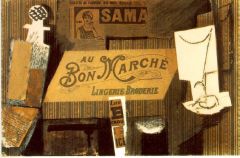
|
Pablo PICASSO Still Life (au Bon Marché) 1912-3 Cubism – Week Two: This is a synthetic art work – a collage representing a table, bottle, glass and sensual lady. These objects emphasize the experience in a café. Bon Marche is the name of a fashion department store. Picasso is conveying crude humour about women. He relates to the nude female figure as a suggestive and erotic male joke. His attitude about art is clear within this work as he quotes “painting should have balls.” He rejected the mainstream values of society, and believed that elegant painters were for the wealthy. The forceful use of materials create a masculine visual to the work. The use of collage embeds the direct use of everyday materials. This work depicts the modern world – one o mechanical reproduction. The changed context of the materials highlights the fact that these images have been massively reproduced. They can be viewed anytime. This is an example of synthetic cubism. |
Pablo PICASSO Still Life (au Bon Marché) 1912-3 Cubism – Week Two: |
|
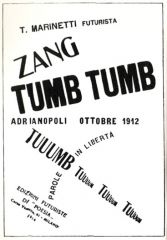
|
Filippo MARINETTI Zang Tumb Tumb 1914 Futurism and Expressionism – Week Three: Marinetti is first and foremost a writer and poet. He used unconventional writing methods- abrupt writing style. Exaggeration and hyperboles. He explored how as an artist he could be a forward sentry in showing the potential of war. Marinetti envisioned himself as a macho hero. The futurists were consistent in how they encouraged violence. The image is the cover on a book of poetry. The cover is about sounds. The writing is about the events in 1912, The Bolkhin War. It was part of the build up to World War 1 which had many smaller battles in its lead up. The Bolkhin War was an important aspect to triggering World War 1 conflict. In Adrianopolis the experience was very loud. The book cover is designed to give a dynamic rhythm. The word sounds evoke the sounds of weapons, actions, weaponry, bullets and war cries. The trajectories of the text portray the text shooting out like bullets in the air. This conveys Marinetti’s passion for war. It shows us the Futurists vision of beauty. He also uses onomatopoeia and evokes the sensation of the sound. The ‘Tuuumb Tuuumb Tuuumb Tuuumb’ text angled with the ‘Parole in Liberta’ phrase uses double symbolism. It also depicts the hilt of a sword. Marinetti’s Zang Tumb Tumb conveys the use of modernist techniques; simplified design and rejection of tradition. |
Filippo MARINETTI Zang Tumb Tumb 1914 Futurism and Expressionism – Week Three: |
|
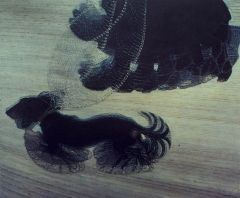
|
Giacomo BALLA Dog on a Leash 1912 Futurism and Expressionism – Week Three: The painting is designed to look like an image. It is domestic looking, the chain suggests control. The domestic pet had only just become widespread in everyday households. It grapples with the question; how do we deal with painting as a traditional medium? Balla was informed by technology. Photography studied movement. There is a sense of jumping, evoked. The rhythm is built up in the painting. Balla has blurred the background faster than the lady and dog. This gives the impression of speed. The ise of diagonal composition infers movement. The painting uses a reduced colour pallete. |
Giacomo BALLA Dog on a Leash 1912 Futurism and Expressionism – Week Three: |
|
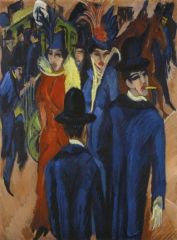
|
Ernst KIRCHNER Street Scene in Berlin 1913 Futurism and Expressionism – Week Three: German expressionism was split into two categories. This painting is incorporated in “The Bridge” – exploring a national identity. Artists in Berlin showcasing their perspective of the city. Berlin as it was evolving. Most of the works emphasize social class and ambiguity. The painting depicts a crowd of people, all compressed within the flat space of the canvas. The figures appear almost identical, this expresses the enmity of the city. There is a strong sense of rushed movement of people. This is conveyed through rushed, jagged strokes that follow movement, vibration, blurred and masked faces. The faces wear a cold and strange expression. Kirchner uses intense colours to depict distorted figures in the rush of the city. The man with his back to the canvas further evokes the compression of space. The painting suggests the woman in the light blue coat gazing at the man. The politics of Berlin at the time were very repressive. The viewer can sense that humanity is removed from this painting, and can feel the frustration of the artist. The connection with Impressionism is tha the emotion is physically manifested in the material used to create the work. |
Ernst KIRCHNER Street Scene in Berlin 1913 Futurism and Expressionism – Week Three: |
|

|
Franz MARC Red and Blue Horses 1912 Futurism and Expressionism – Week Three: “The Blue Rider”- Southern German movement which explored the metaphysical. Marc conveys the sense of the animals experience with the landscape. There is use of SUBJECTIVITY: which can be defined as: the sum total of things that shape how we see the world. The “Blue Rider” artists were interested in the radical idea of “inter-subjectivity.” The use of colour is symbolic. Blue is spirit. Red is physical matter. Yellow is feminine or nurturing. The painting uses flattened, compressed planes and soft, blended brushstrokes. Liquidity – prismatic sense. Marc has used strong, bold lines to convey the form of the horses and landscape. There is use of optical lens of light. Delicate horses have a radiance. This is created by light instead of shadow. The shadow has been inverted. The strong use of colour softens composition. |
Franz MARC Red and Blue Horses 1912 Futurism and Expressionism – Week Three: |
|
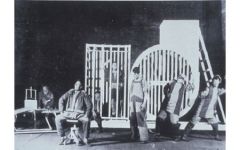
|
Varvara STEPANOVA (1894-1958) Acting Apparatus, Death of Tarelkin 1922 Russian Constructivism – Week Four: This is a still photograph of the play Acting Apparatus, Death of Tarelkin. It was a controversial criticism of apparatus being overwhelming. The design incorporates machinery and costumes. It draws on the idea of the “theatrical machine’ and how the individual can become part of the whole. This was formed by the interest in machinery and industrialization. The design concepts of this play were informed by the Brecht idea of the mechanization of the theatre and exposing this to the audience. The formal elements have been broken down and then re-assembled. The visual elements are; geometric lines, patterned and reduced colour patterns, material qualities of the set and the re-assemblage of the materials. This theatre design removes the hierarchy of stage crewing. Stepanova has drawn upon a Bolshevik idea of the proletarians; run by and for the workers. |
Varvara STEPANOVA (1894-1958) Acting Apparatus, Death of Tarelkin 1922 Russian Constructivism – Week Four: |
|

|
Vilmos HUSZAR De Stijl Magazine Cover 1917 De Stijl – Week Six: This is the cover of the first De Stijl magazine. The cover contained an abstract woodcut composed of black rectangles. The title, De Stijl is arranged in fragmented square capitals. The design is reduced to geometric shapes. Huszar has reconciled polar opposites of the design by using; contrasts, black and white operating as separate tones, figure ground (complex relationship where you cannot tell which is the foreground or background), horizontal and vertical brought into proximity without joining (still understand as separate elements but portraying something bigger) and the image and text are integrated (separate but function together.) |
Vilmos HUSZAR De Stijl Magazine Cover 1917 De Stijl – Week Six: |
|
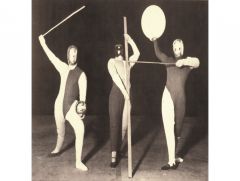
|
Oskar SCHLEMMER Form Dance 1927 The Bauhaus – Week Five: Schlemmer was a German painter, sculptor, designer and choreographer associated with the Bauhaus. In 1923, he was hired as Master of Form at the Bauhaus theatre workshop, after working some time for the workshop of sculpture. His complex ideas were influential, making him one of the most important teachers working at the school at that time. He was the Master of the Theatre department. Before architecture, the theatre was a good way to bring all the arts into the theatrical department. Discontinued theatre from 1929. Seen as very important figure in modern dance and art/design. Performances originally done by Bauhaus students. Schlemmer was an artist first and then a choreographer. Intentions of theatre and dance provided a way to collaborate interdisciplinary. It was an opportunity to bring all of the arts together (idea of a whole art). The elements pulled together observe content and form. Constructivist ideas are embedded into the performances: being abstract both conceptually and aesthetically. The theatre was ephemeral – a place to experiment. |
Oskar SCHLEMMER Form Dance 1927 The Bauhaus – Week Five: |
|
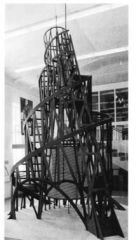
|
Vladimir TATLIN Monument to the Third International 1919 Russian Constructivism – Week Four: Tatlin’s work is a scale model for a proposed monument. It was intended to be a statement of what soviet society had achieved. The monument was designed to incorporate functional spaces, built with a social purpose. In its finalized design it was a huge scale. The double helix represents synthesis. It represents the Marxist idea of a dialectic. Tatlin has used dynamism within the work. The diagonal signifies moving forward. Its conceptual idea is meant to give power to the people. The monument was intended to be a revolutionary equivalent of the Eiffel tower. It was meant to incorporate the seat of government, media and distribution. Tatlin anted to see art that had a social purpose. Marxist theory is interlinked within the concept of the Monument. Marxists’ dialectic model becomes a physical form. The double helix shows the notion of the thesis and physical representation of Marxist theory of Capitalism. There wasn’t enough metal in the whole of Russia for a monument this scale. It was never built. All that was created is wooden models. In principle the monument was meant to be a wonderful example of steel engineering. |
Vladimir TATLIN Monument to the Third International 1919 Russian Constructivism – Week Four: |
|
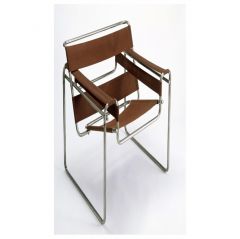
|
Marcel BREUER Model B3 (Wassily Chair) 1925 - 1928 The Bauhaus – Week Five: This chair was innovative because of its use of tubular steel; it was strong, lightweight, collapsible and portable. Breuer was looking at the process of manufacturing an unrelated object (the bicycle used tubular steel) and seeing how the material could be applied in other ways. The chair is multi-functional. Breuer moves beyond the “platonic form”, a generic idea to asking “what does a chair actually do?” Breuer was willing to let go of the archetypal chair and look at its purpose. This was to reassess and re-create it. It was a radical assessment of what materials can do. Breuer was first a student at the Bauhaus and later became a teacher there.How do we reproduce the idea of comfort of lounge chair with industrial needs. Tubing of bikes applied- timeless and important design. Canvas webbing. Originally highly influenced by De Stijl. These chairs used as furniture at the Bauhaus. |
Marcel BREUER Model B3 (Wassily Chair) 1925 - 1928 The Bauhaus – Week Five: |
|
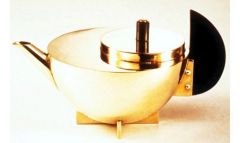
|
Marianne BRANDT Small Tea-Essence Pot 1924 The Bauhaus – Week Five: This is a tea essence pot. The idea was to create a strong pot of tea, you would put a little bit in a cup and put fresh hot water in it (use the same pot of tea all day.) Scale and preciousness is key to the design of the pot. Brandt has drawn from constructivism by pairing back elements and then re-creates these using shapes and forms. The materials used for the pot were brass and ebony (wooden.) Using the ebony was an innovative idea for a handle because it stops the hand from burning when picking up the tea pot. Wood is not a good head conductor. She also used a circular lid so that the tea doesn’t pour out the top. The base is a simple cross strut- should still be able to recognize elements in the object or art. Brandt became one of the only female teachers at the Bauhaus because of her talent and skills. Women in the Bauhaus: difficult position that women had at the Bauhaus. Gropius at start worked on gender equality- problematic. Saying that meant that incredible amount of women enrolled in the Bauhaus. Dream compromised. Most women put into the weaving workshops. More women than mean applied to the school in 1919. “There will be no difference between the beautiful and the strong sex.” The textile and weaving workshops changed the face of modern textile design. Two exceptions: Marianne Brandt. Originally studied at the School of Fine Arts- then enrolled into the Bauhaus. Qualified in metal trades- employed as a master assistant in the workshops. When master left- she was assigned as acting head of the workshop. Problem was she couldn’t be seen as a master of a class of men. Gropius employed her in 1929 in his own private architecture firm- returned to teaching in the 1940s-50s. One of the most talented in the metal workshop. Tea pot: brass with silver lining- elemental shapes more easily manufactured. Love of metal surfaces evidenced in her photography. |
Marianne BRANDT Small Tea-Essence Pot 1924 The Bauhaus – Week Five: |
|
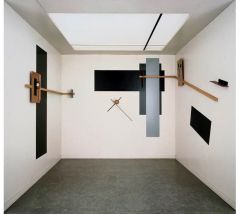
|
EL LISSITZKY Proun Room (Reconstruction) 1923 New Ideas: Installation, The Machine Aesthetic and The Grid – Week Seven: The Proun Room was an axonometric design based on suprematist ideas. Lissitzky was nterested in architectonics; the science and process of architecture was analysed and realized. Projects were for affirmation of the new. Lissitzky was trained first as an engineer and studied architecture before he became a graphic design teacher. He was Constructivism’s ambassador to the west. In 1926 Lissitsky declared the death of easel painting because the cinema and illustrated magazine became much more powerful than painting. There is srong use of axonometric plans as an alternative to one point perspective. The idea was to can explode open 3-dimensional space to show the true relationship between all the forms. It looks like the room has been unfolded. The viewer cab see the actual ratios so it is mathematically correct. The Proun Room immerses the viewer in a total environment. No element is divisible from itself. Nothing can be taken anything away. The sculptural work is integrated into the forms of the room. It is a laboratory. A place where spatial experiments take space. There is nothing personal (personal and individual left behind in the collective good- constructivist idea). Lissitzky was involved in a lot of spatial experiments later on. He developed connections to Hanover (integrating ideas into gallery spaces). |
EL LISSITZKY Proun Room (Reconstruction) 1923 New Ideas: Installation, The Machine Aesthetic and The Grid – Week Seven: |
|
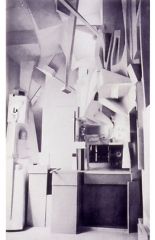
|
Kurt SCHWITTERS Merzbau 1920-1943 New Ideas: Installation, The Machine Aesthetic and The Grid – Week Seven: Schiwtters took the total environment much further. He was not left wing at all but instead very individualist. Schiwtters was financially independent (inherited four properties in Hanover and a good graphic design business). The Merzbau can be considered as one of the most eccentric spaces of 20th century. Schiwtters was connected to all of the most significant artists of the era. He was interested in ideas similar to other 20th century artists. He pursued it seriously. Schiwtters was connected with El Lissitzky. The Merzbau is the sum of 20 years of work. Schiwtters exhibited a key interest in interdisciplinary arts. The whole way of making through art forms was dictated by Merz (commerce.) Schiwtters was looking at some torn up pieces had been part of commerce for a bank. Merz- term as a way of thinking about the modern work. Schwitters comes up with this word. It explores what is left behind of the rational ideas of the world. What is rejected, ignored? He created a publication where he experimented with typography. He fixated on processes of making assemblages of debri. Scwitters biggest work is the Merzbau. It was an architectural construction, a cathedral of erotic misery. Embedded early ideas of surrealism. Schwitters started building it by putting collections of ephemera together(stuff that isn’t meant to be together). Collections of things less palatable (hair, jar of urine…). It grows organically like a plant or mould. He started off with models of stuff and built into grottos that started to grow. The room becomes unrecognizable. By 1936 he had completely filled his studio. He punched a hole into the ceiling of the next floor to create more room. Concept that architecture that is viral. Schwitters planned multiple Merzbau constructions. He was interested in the sense of something that builds itself. Sometimes grottos were shrines to murderers and artists (interwar Germany interested in murderers). He was inspired by his own poems. Schwitters metabolized various ideas from friends and responded to those in the work. He was forced to leave Germany in 1937. First he was in Norway then fled to England. In England, Schwitters started to build a Merzbau. The Germany Merzbau was destroyed by a bombing. The final Merzbau was left unfinished in England. In Hanover there was documentation of the Merzbau. Hanover had reconstructed the Merzbau. |
Kurt SCHWITTERS Merzbau 1920-1943 New Ideas: Installation, The Machine Aesthetic and The Grid – Week Seven: |
|
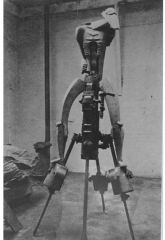
|
Jacob EPSTEIN Rock Drill 1915 New Ideas: Installation, The Machine Aesthetic and The Grid – Week Seven: Epstein was American born and became a British citizen. This is an important sculpture. Epstein previously worked in an art deco style. There was controversy around Oscar Wilde tomb. This is a produced radical work of Vorticism. A found object is transformed into a sculptural form. The torso shape is integrated into a machine. Epsetin was horrified by what he had made. The torso was cast into bronze. This sculpture made Epstein reflect on the horrific idea of Frankenstein. A person becomes thing that is capable only to destroy. Although some artists were fascinated by the idea of the human machine, not all artists were interested in aggression or violence. |
Jacob EPSTEIN Rock Drill 1915 New Ideas: Installation, The Machine Aesthetic and The Grid – Week Seven: |
|

|
Francis PICABIA Girl Born Without a Mother 1918 New Ideas: Installation, The Machine Aesthetic and The Grid – Week Seven: Picabia was an individual artist who spent a lot of time in different art groups. He took great delight in the machine and predicted the connection between the machine and leisure. Cars were his passion. He worked through a succession of cars. His love of cars were his saving grace as he became a driver for the army. This particular work is very harsh, Dadaist and brutal. Unlike some of Picabia’s other playful and erotic works, this work takes on a serious perspective about the harsh realities of World War One. The work references the destructive and violent capabilities of the machine. It shows a harsh reality about the horrific loss that war machinery brought. |
Francis PICABIA Girl Born Without a Mother 1918 New Ideas: Installation, The Machine Aesthetic and The Grid – Week Seven: |
|
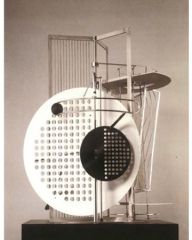
|
László MOHOLY-NAGY Light Space Modulator 1922-1930 New Ideas: Installation, The Machine Aesthetic and The Grid – Week Seven: This is a machine that experiments with light and movement. It embeds utopian visions characterized by the Constructivist. Mastering this technology served his own formal ends. It explores how light and space interrelate. It was an experimental object that integrated colour. It was used as a light-prop. The intention was to synthesize simple objects. There is a two minute program of 116 lights that were used to shine on the machine. However this has not ben seen in its original context. Moholy-Nagy used as a subject matter for an experimental film. Things shift around and show the relationship with the lights. Fundamental to its arrangement is a grid arrangement. How do we plan things? We do it on graph paper with a grid. The grid is a defining logic of the 20th century. |
László MOHOLY-NAGY Light Space Modulator 1922-1930 New Ideas: Installation, The Machine Aesthetic and The Grid – Week Seven: |
|
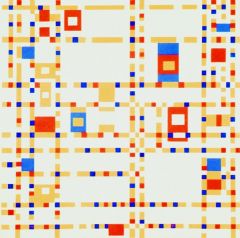
|
Piet MONDRIAN Broadway Boogie Woogie 1942-43 De Stijl – Week Six: Mondrian uses a series of coloured vertical and horizontal lines, with coloured squares forming a dynamic rhythm within the work. He abandons the defining black lines in favour of bursts of primary red, blue and yellow set amidst a neutral background. Influences of Mondrian’s interest in jazz culture and the exhilarating lifestyle experienced in New York can be seen in the lively stylistic expression of this painting. Broadway Boogie Woogie (1942-43) captures the very essence of energy and rhythm. It is abstract in the pairing down to a direct expression of sensational experience of the modern. It represents a departure from Mondrian’s previous more austere, abstract and static paintings to a more dynamic expression (Gayford, 2001). |
Piet MONDRIAN Broadway Boogie Woogie 1942-43 De Stijl – Week Six: |
|
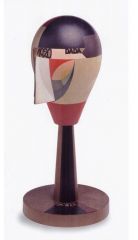
|
Sophie TÄUBER Dada Head 1920 Dada – Week Eight: What is the new human? What does is mean to be human in the 20th century? What does a wooden head symbolize? Human is a mutation of the philosophical man: proposes whole new range of heads- junk heads, mechanical heads, severed heads. Self or human subject altered by the course of human events. No avoiding the damaged self. This is a sculpture of a re-arranged, deformed head. Tauber has reduced the elements to geometric forms. The head carries the spirit of Dada, that it has been altered by encountering the spirit of Dada. The head is multi-purpose, it acts as a portrait and a hat stand. It is both an art object and dumb everyday object. The head is made of solid wood with reference to African masks. It explores what it means to be a conscious thinker. The quote “I think, therefore I am” is very relevant. It challenges the separation of art and life. The artistic style of the art object gives reference to different cultural representations. This is a quality of Dada; pan-cultural. The deformed head also references mutation; people mutated by World War One. |
Sophie TÄUBER Dada Head 1920 Dada – Week Eight: |
|

|
Hannah HÖCH Cut with the Kitchen Knife Dada through the Last Weimar Beer-Belly Cultural Epoch of Germany 1919-1920 Dada – Week Eight: Hoch used collage and photomontage to critique the corrupt politics of the Weimar German Government. She used mass-media images and text re-arranged to create highly satirical and political art works. This work depitcs the corruption and political conservatives of Weimar. The forces of dada trying to rebel. The map in right corner shows where women are allowed to vote. The viewer gains the sense that she is putting the political position of women within a larger context of political events. There is a different idea of the Dadaist head depicted in this work. She layered images of war machinery, political figures, provocative text and dramatic figures to create an explosive and theatrical environment. Hoch asks the viewer to be a critical thinker and consider the political issues she is referencing in her work. |
Hannah HÖCH Cut with the Kitchen Knife Dada through the Last Weimar Beer-Belly Cultural Epoch of Germany 1919-1920 Dada – Week Eight: |
|
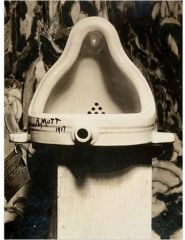
|
Marcel DUCHAMP Fountain 1917 Dada – Week Eight: Work as seen as one of the most significant artworks because Duchamp is questioning authorship. He questions the value of the art object, what is the object? What are its aesthetics? He was working within a society of independent artists inspired by exhibition of Modern European Art. They saw themselves as the spirit of Modernism. In the 1917 exhibition they claimed that no work not too radical to be included. Duchamp submits the work with urinal tipped on its side. It was signed by a fictitious artist and became an art object because it is side. Duchamp used Dadaist provocation. He also tried to claim he started Dadaism. This work brings into criticism the sanctity of art. Duchamp is questioning if art still exists, or is it dead? The gesture of tipping the urinal on its side makes it functionless, and labels it as an art object. The work is conceptual. It is the product of mass-production and questions the notions of 20th century beauty. Duchamp argues that art is seen as a ‘technical trode’ and that artists need to exist in the world of ideas. He draws upon the Dadaist concepts of an “anti-art” and “anti-aesthetic.” Fountain is designed to provoke critical questioning of cultural values. |
Marcel DUCHAMP Fountain 1917 Dada – Week Eight: |
|
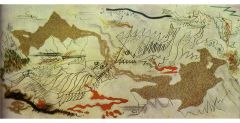
|
Andre MASSON Battle of Fish 1927 Surrealism – Week Nine: Masson was severely injured from WW1. He was trying to make sense of what he and Europe had gone through. Masson worked as a Cubist painter to begin with. He developed a visual equivalent for automatic writing. Automatic writing can be defined as; developing visual art equivalent of letting ideas flow. This work incorporates doodling. Glue and sand poured spontaneously onto the canvas. The lines responded to shapes formed from the sand. In the end Masson developed a revulsion of cubism. |
Andre MASSON Battle of Fish 1927 Surrealism – Week Nine: |
|
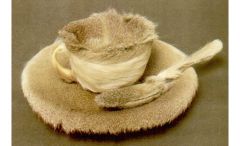
|
Meret OPPENHEIM Object (Déjeuner en fourrure) 1936 Surrealism – Week Nine: Woman surrealist that starts off as a muse. A very attractive young woman. She was an incredible powerful young woman artist. Oppenheim was born in Germany from Swiss parents. She was persuaded to live in Paris from some artist friends. In Paris she gets in contact with the Surrealists. She was invited to participate in a Surrealist exhibition at only 20 years old. It was a key exhibition that changed the role of women in surrealism to become artists. This is her best known work. She made fur covered jewellery – Breton said you could cover anything in fur. She responded with this object. Melding of two key favourite surrealist moments: luncheon in furs. This work caused a huge scandal. It had strong sexual references and was considered very scandalous. It was purchased by MOMA. In 1937 Oppenheim had a crisis what was happening in art. Responding to the politics and questioning her own identity. She stopped making art until the 1950s. Oppenheim said she was perhaps never a surrealist but her own artist.Surrealists responded well to this work because it was uncanny, removed habitual function, materials out of context, issues and relationships of hair and fur. It also draws reference to genitals. |
Meret OPPENHEIM Object (Déjeuner en fourrure) 1936 Surrealism – Week Nine: |
|
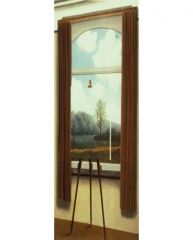
|
Rene MAGRITTE The Human Condition 1933 Surrealism – Week Nine: Rationalize things to complete falsity. Surrealist ideas:That representation has its limits. It is in some ways a lie. Always an artifice. Wanted to liberate the mind: destroy preconceptions of the mind. Logical assumptions: what is outside the window? Subtle hints: meant to give us a double-take. Look, see something, look again. Looking again starts to give unease. Sense of our ability for the mind to fool us and to trick us important to understand. |
Rene MAGRITTE The Human Condition 1933 Surrealism – Week Nine: |

